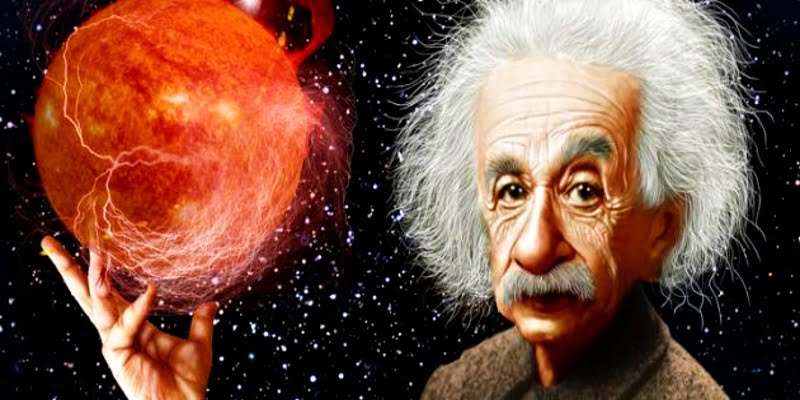Einstein’s theory of relativity explains the behavior of objects in space and time. It states that space and time are relative, and all motion must be relative to a frame of reference. For more details, read this article.

What is Einstein’s Theory of Relativity? Explained
Who is Albert Einstein?
Many people have heard of Einstein and his genius, as he was a German physicist born in 1879. Albert Einstein is called the father of relativity for his development of the theory of relativity in physics, which was a major turning point in the history of physics.
Albert Einstein was awarded the Nobel Prize in Physics in 1921 and moved from his country, Germany, to Switzerland, and then to the United States of America.
Einstein was born to a Jewish family in Munich, and he was suffering from poor comprehension, but one of his uncles supported his love for science and brought him science and mathematics books, and helped him move to Switzerland, where the method of teaching was different from Munich.
In addition to physics, Einstein loved music, especially Classical Music by Mozart and Bach, and he played the violin at concerts for charitable purposes.
Einstein’s Theory of Relativity
There has been much talk about the theory of relativity, and how it changed many concepts related to classical physics that prevailed from Newton’s time until Einstein’s theory appeared.
The theory of relativity, which is also called relativity, is a theory of the German scientist Albert Einstein, and the French scientist Henri Poincaré who made other valuable contributions to relativity theory.
The three laws of motion developed by Newton for several decades remained a given, until the physicist Einstein published in 1905 a paper questioning the accuracy of these laws, which is now known as the special theory of relativity.
Then the theory of relativity followed it with the general theory of relativity, which touched on the subject of gravity and demonstrated the lack of the prevailing understanding of it, as this understanding relied mainly on Newton’s law of gravitation.
The theory of relativity is considered one of the most important modern physical theories, because of its role in changing many physical concepts.
Researches related to this theory were published in 1905 by Einstein. They were related to answering questions about the properties and behavior of light, and the results of the Michelson–Morley experiment on light, and the experiment examined the spread of light in different directions. The experiment results were in contradiction with the well-known classical laws of velocity.
The importance of relativity theory lies in the fact that it changed the basic physical concepts related to mass, energy, space and time, and made a qualitative leap in space physics and theoretical physics, and modified Newton’s mechanical physics theories that prevailed 200 years ago, where the relativity theory states that the motion of bodies is relative with the change of time, and that the concept of time is no longer fixed and definite.
The theory of relativity linked space and time so that it deals with them as one thing called space-time after they were treated as two different things and linked time with the speed and movement of the body, as there are concepts of contraction and expansion of time in the universe.
Special Theory of Relativity
The theory of special relativity included two basic assumptions, the first states that the laws of physics are relativistic and variable depending on the situation or context, and Einstein came to this belief by observing static and moving objects at constant speeds.
For example, when observing an object suspended by a moving train, the person standing outside the train sees that the object is moving from one position to another at a certain speed, but if a person looks on board the train itself, he will not distinguish the movement of the object, and will see him at rest. This hypothesis applies to all particles of different nature, except for light. Thus, Einstein formulated his second hypothesis from the special theory of relativity and emphasized that the speed of light is constant, even with a different reference context.
General Theory of Relativity
Einstein published the general theory of relativity in 1916, and the importance of this theory lies in the fact that it has linked time, gravity, space, and acceleration. Einstein was also able with this theory to explain many cosmic phenomena that have been puzzling for centuries, and he also predicted the existence of black holes.
It is worth noting that this theory took seven years of work to reach the degree of completeness and depth.
Examples of Relativity
- Suppose a person is watching television, he will think that both himself and the television are stationary, this is true for the place in which he is, but not true for the universe. The person and the TV move under the influence of a group of movements, including the rotation of the Earth around the sun, the rotation of the Earth around itself, the movement of the solar system in the Milky Way, and the movement of the galaxy in the universe.
- Suppose twins are born at the same time, one of them stayed on Earth and the other left the planet at the speed of light for a year and then returned at the same speed again to Earth, he will find that his twin has reached the age of fifty years and he is still two years old. The reason for this is the time dilation of the traveling twins as a result of their movement at the speed of light.
Why was Einstein’s Theory of Relativity So Important?
The theory of relativity has worked to explain and understand many hypotheses and phenomena, through which scientists were able to understand the nature of interactions that occur between particles, which contributed significantly to the development of some sciences, including nuclear sciences, which increased interest in them after the emergence of the theory of relativity and explained many aspects of the behavior of particles.
It also contributed to the explanation of many cosmic and space phenomena, such as gravitational waves and black holes in space.
The theory of relativity in general included more than one physical theory, the most important of which was the special theory of relativity, which was published in 1905, was accepted in 1920, and is concerned with the values of small molecules and their interactions. It has been used by physicists in atomic physics, nuclear physics, and quantum mechanics.
As for the general theory of relativity, which was published in 1906, it is concerned with large astronomical values, and the motion of cosmic bodies.
Hypothesis for Correcting the Theory of Relativity
The special theory of relativity consists of hypotheses that depend on it and form the basis of the theory. These hypotheses are:
The stability of the speed of light: The relativistic theory proves that light has a constant speed, regardless of its source and location, and that it does not need a medium to move from one place to another.
Time is the fourth dimension: Einstein is considered the first to put time as a fourth dimension after the length, width and height of matter, and he entered the fourth dimension in all his calculations.
Denying the existence of the ether: The ether is the thing that exists in the universe and has no limits, and all scientists believed in its existence, but Einstein denied its existence and said that there is only relative place and relative speed.
Newton’s laws conflict with relativity
Einstein spent most of his time studying Newton’s physics, and found a mistake in defining Newton’s time and place, as according to Newton’s laws it was possible to reach the speed of light, but for Einstein, this is impossible; For the lack of infinite energy to reach this speed, and this cosmic energy is limited.
The two scientists, Isaac Newton and Coulomb, agreed on the laws of motion and charges, where Newton said that nobody moves on its own unless it is affected by a force that moves it, but this theory developed by Newton does not apply to stars, they exist in a vacuum and move without being affected by forces.



